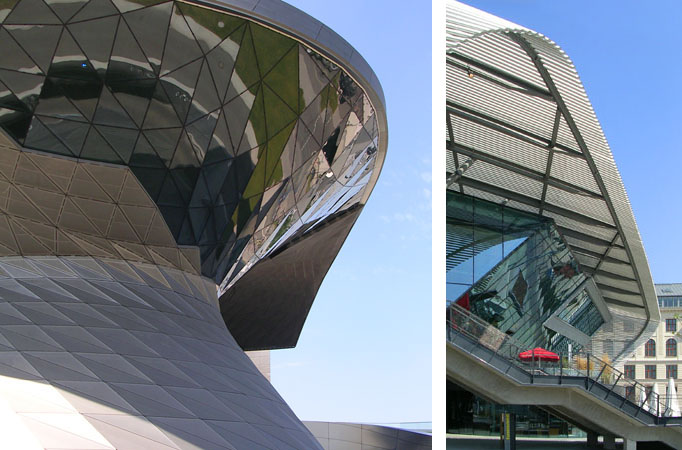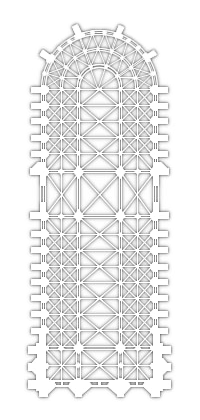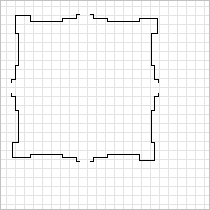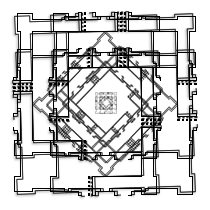1
Configuration / Parametrics
| EN | DE |

Configuration: Form, as depending on the relative disposition of the parts of a thing's shape; the way things are arranged or
put together in order to achieve a result;
Parameter: From Ancient Greek para ("beside") + metron, ("measure").
An input variable of a procedure definition, that gets an actual value at execution time;
(Source: Wiktionary)
| Democratic Design |
1) Dynamic interactive systems redefine the relationship between humans and artefacts. The motivation behind research
groups like SERVO and KRETS was "the notion of democratic design" - that is, a collaborative digital environment
where the roles of designer, user, performer, and manufacturer could overlap. The creative environment of
UrbanToys, for example,
integrated users as co-authors by providing a set of materials, functions and variables. Users could browse a catalogue
of generic objects, explore technological options, edit in 3D, and output a physical prototype.
The configuration of objects using a digital design environment involves:
2) Product configurators have gained a lasting commercial presence: Pre-designed adaptable architectures, customer inclusion in the design process, or dynamic product simulation, ensure both customization and structural viability (Endress+Hauser). A product configurator turns users into co-designers. They navigate hierarchical product descriptions with a menu-driven interface, make specific technical or aesthetic choices, and place their order online. |
||
|---|---|---|---|

|
|||
| Configurable Objects (Doc. ref.) | |||
| Parametric Systems |
Architects who grasp the world in terms of forces and flows, rather than fixity and representation have used scripting techniques
to generate completely new forms. [...] In a digital environment, topology, time and parameters can be utilized to model a set of
relations by linking them to the attributes and behaviours of a parametric structure via logical expressions. [...] A mountain,
for example, enables the flow of water by geologically storing "virtual force and motion." By extension, the sets of relations
existing between water, gravity, sunlight and trees must be such that a piece of wood can produce kinetic energy both by falling
through air and rising through water.
Parametric responsiveness includes the "real-time kinetic adaptation" of physical structures and surfaces, electrically actuated transformations of materials at the micro level, as well as 'programmable matter' which is based on nanotechnology. |
||
| ➔ State of the Practice | |||
| Project: Shape Grammar |
b. The diagrammatic set of shape rules is based on a right-angle square, as well as a 'bounding box' with four central openings to form an initial shape. c. The parametric set of rules involves a notation in pseudocode where [n means number and] P is the set of all points affected by a transformation. (R4) P:transform {scale (width: n% height: n%); angle (n°);} (R5) P:transform {coords (x +- n y +-n); angle (n°);} |
||
| Evolutionary Architecture | The generation of digital architecture involving computational models based on nature emulates evolutionary processes to shape artefacts and design. In John Frazer's evolutionary architecture, the composition of the object [as phenotype] is converted into genetic algorithms, subjected to design criteria, and interactively modelled in a virtual environment. This facilitates the development and iterative adaptation of prototypes for evaluation, crossovers, and mutation. The design practice again becomes a problem-solving assignment with objectives, mapping procedures, and constraints. An optimum solution requires the calculation of chromosome/population fitness and aesthetically pleasing forms. The generative script, containing sets of instructions to steer a system of genotypes, can be used in a computer simulation in order to investigate emerging forms. | ||
| ➔ Silicon Domain | |||
| Case Study: French Gothic Architecture |
|
||

|
|||
| Project: Pre-Cursor Prototype |

The Pre-cursor project [for Social Change Design 89304; University of Technology, Sydney] encompassed research in the area of United Nations Conflict Prevention, as well as the construction of a low-fidelity prototype. The purpose of the prototype, made using Adobe Flash, was to initiate a repository for the researched information and to design an appropriate user interface. The Pre-cursor prototype is structured around eight root causes of - and a selection of UN institutional responses to - potential armed conflict. This allows users to: (1) Discover major causes of potential conflict, (2) Explore generic UN institutional responses, and (3) Generate a simple report. |
||
| Pre-Cursor (Doc. ref.) |


